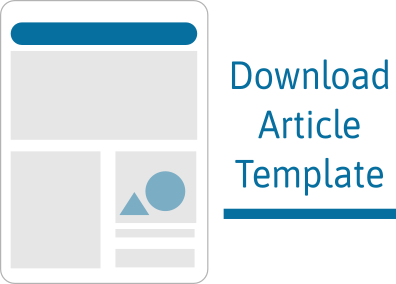Author Guidelines
Types of Papers
Contributions to JFI are classified into Research Paper and Technical Note.
- Research Papers should be a well-organized thesis based on original theories of experimental research and technical achievement.
- Technical Notes, should be of contents describing new research and technical achievements, ideas on new issues, and contents complementing or revising previously published papers.
- Short Communications, should be used for shorter articles with the same structure as a Research Papers.
Before submitting, authors are asked to consider these following points:
Submission Declaration :
Articles have not been published or accepted for publication(except in the form of an abstract or as part of a published lecture or academic thesis), or are being considered for publication elsewhere. In addition to the manuscript, a written statement should be attached which clarifies that the article is original and does not contain any elements of plagiarism.
Changes of Authorship :
The list and the order of Authors should have been fixed carefully before submitting their manuscript and provide the definitive list of authors at the time of the original submission. Any addition, deletion, or/and arrangements of author names in the authorship list should be made only before the manuscript has been accepted and only if approved by the journal Editor.
The structure of manuscripts should be electronic files and follow these formatting requirements:
TITLE PAGE
Must be brief, informative and indicates the main point(s) of the paper, maximum 15 words.
AUTHORS NAME
Must be complete but without any title, affiliation address, and e-mail address of the corresponding author.
ABSTRACT
The abstract should state briefly the purpose of the research, method(s), and major conclusions. An abstract is often presented separately from the article, so it must be able to stand alone. For this reason, References should be avoided, but if essential, then cite the author(s) and year(s). Also, non-standard or uncommon abbreviations should be avoided, but if essential they must be defined at their first mention in the abstract itself. The abstract should not exceed 300 words and is constructed in one paragraph. Authors should provide abstract written in two languages: Bahasa Indonesia and English.
Keywords
Should be provided below the abstract to help with the electronic search (3-7 words)
INTRODUCTION
State the objectives of the work and provide an adequate background, avoiding a detailed literature survey or a summary of the results. State why the study is necessary.
METHODS
This section should include the aim(s), design, and setting of the study. A clear description of all processes and methodologies employed.
RESULTS
Results should be clear and concise.
DISCUSSION
This should explore the significance of the results of the work, not repeat them. Avoid extensive citations and discussion of published literature.
CONCLUSION
The main conclusions of the study may be presented in a short Conclusions section, which may stand alone or form a subsection of a Discussion or Results and Discussion section.
REFERENCES
Citation in text
Please ensure that every reference cited in the text is also present in the reference list (and vice versa). Unpublished results and personal communications are not recommended. Citation of a reference as 'in press' implies that the item has been accepted for publication.
Some examples:
- and satellite-based methods such as interferometric synthetic aperture radar (InSAR) data (Ferretti 2014) and light detection and ranging (LiDAR) observations
- such as finite-differences, finite-volume (Bailey & Cross 1995; Fallah et al. 2000), or finite-elements (Igel 2017)
Web references
As a minimum, the full URL should be given and the date when the reference was last accessed. Any further information, if known (DOI, author names, dates, reference to a source publication, etc.), should also be given. Web references can be included in the reference list.
Reference list
Alphabetized reference list entries enable by the last names of the first author of each work. Please alphabetize according to the following rules: 1) For one author, by name of the author, then chronologically; 2) For two authors, by name of the author, then name of coauthor, then chronologically; 3) For more than two authors, by name of the first author, then chronologically.
- Journal article including doi
Bailey C., Cross M., 1995. A finite volume procedure to solve elastic solid mechanics problems in three dimensions on an unstructured mesh, Int. J. Numer. Methods Eng., 38, 1757–1776., doi.org/10.1002/nme.1620381010
- Book
Igel H., 2017. Computational Seismology - A Practical Introduction, Oxford Univ. Press
- Book chapter
Brown B, Aaron M (2001) The politics of nature. In: Smith J (ed) The rise of modern genomics, 3rd edn. Wiley, New York, pp 230-257
- Online document
Cartwright J (2007) Big stars have weather too. IOP Publishing PhysicsWeb. http://physicsweb.org/articles/news/11/6/16/1. Accessed 26 June 2007
- Dissertation
Suryanto, W. (2006), Rotational motions in seismology, theory and application, Dissertation, University of Munich, Germany.
Always use the standard abbreviation of a journal’s name according to the ISSN List of Title Word Abbreviations.
Reference management software
Users of Mendeley Desktop can easily install the reference style for this journal by clicking the following link:
http://open.mendeley.com/use-citation-style/journal-of-cereal-science
When preparing your manuscript, you will then be able to select this style using the Mendeley plug-ins for Microsoft Word or LibreOffice. All publications cited in the text should be presented in a list of references following the text of the manuscript. The number of references ranges from 15 to 25 positions. The manuscript should be carefully checked to ensure that the spelling of authors' names and dates are exactly the same in the text as in the reference list.


















